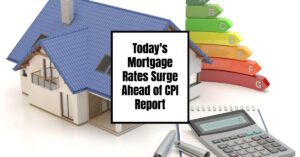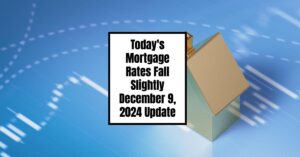In a significant development for potential homebuyers and those considering refinancing, today’s mortgage rates fall again, with the average rates dropping across all major loan categories. According to data provided by Bankrate, the average rates for 30-year fixed, 15-year fixed, 5/1 adjustable-rate mortgages (ARMs), and jumbo loans all declined, marking a shift in the housing finance market as of December 12, 2024.
Today's Mortgage Rates Fall Again – December 12, 2024: Key Insights & Trends
Key Takeaways
- Lower Rates: Mortgage rates decreased for all major types of loans this week.
- 30-Year Fixed Rate: Now at 6.73%, down from 6.79%.
- 15-Year Fixed Rate: Decreased to 6.03%, down from 6.09%.
- 5/1 ARM Rate: Now stands at 6.07%, down from 6.19%.
- Jumbo Loans: Average rate reduced to 6.79%, down from 6.84%.
The stay of the Federal Reserve's monetary policy is affecting these numbers. After cuts in September and November 2024, potential future cuts may further influence the housing market, driving rates lower and potentially leading to increased home purchases and refinances. All data referenced is accurate as of December 12, 2024, per Bankrate’s reliable reporting.
The Current State of Mortgage Rates
Mortgage rates are not static; they shift based on a multitude of factors including economic indicators, the Federal Reserve's decisions, and shifts in investor sentiment. With the recent cuts in interest rates by the Federal Reserve at their meetings in September and November, speculation about further reductions has begun to affect market rates. The Federal Reserve does not directly set mortgage rates, but its actions impact overall economic conditions, which in turn influence mortgage borrowing costs.
The 30-year fixed mortgage rate currently sits at 6.73%, down 6 basis points from last week. This is a modest reprieve for homeowners considering a new purchase or refinancing their existing loans. For instance, at this rate, if you borrowed $100,000, your monthly payment would be approximately $647.27 for principal and interest. Compared to last week, that's a savings of about $3.99 monthly. Consumers are seeing a bit of relief in their monthly budgets, which can be incredibly beneficial when considering home expenses.
The 15-Year Fixed Rate Trend
Looking at the 15-year fixed mortgage rates, today’s average is 6.03%, a decline from 6.09%. The lower rate means that a borrower would pay around $845 per month for every $100,000 borrowed. This loan term can lead to significant interest savings over time, making it a popular choice among those who aim to pay off their mortgage equity more quickly. The long-term savings can build wealth in a homeowner's favor—good news for financially-savvy buyers.
Adjustable-Rate Mortgages (ARMs)
For 5/1 ARMs, the average rate has made a more significant drop to 6.07%, translating to about $604 per month per $100,000 borrowed. This type of mortgage typically begins with a lower initial interest rate for the first five years and then adjusts periodically. With the current rate drop, these loans become an attractive option for buyers who may not stay in their new homes for a long duration.
Recommended Read:
Jumbo Loans
Turning our attention to jumbo loans, which cater to more expensive properties, today's average rate is 6.79%, a decrease of 5 basis points from last week. This decrease is particularly valuable given that jumbo loans often come with higher risk and, thus, higher rates. Previously, just a month ago, rates for jumbo loans were over 6.97%, so today's rates show a notable trend towards more affordability for higher-end homebuyers.
Market Reactions and Predictions
As we observe these trends, investor behavior remains a crucial factor. The decline in mortgage rates indicates buoyancy in the market. Increased buying activity is often driven by lower borrowing costs. Many potential homeowners are expected to act on these rates, leading to a potential surge in home purchases during this season.
In addition, financial analysts suggest that volatility may continue, with forecasts indicating that rates could dip lower as investors flock to low-risk Treasury bonds. In uncertain economic times, when the market shows signs of instability, rates often move downward as risk aversion increases. Greg McBride, a chief financial analyst at Bankrate, noted, “Expect volatility and unpredictability with bond yields and mortgage rates netting out a bit lower.”
Comparative Perspective: Historical Rates
Looking back at the historical context of mortgage rates, today's averages present favorable conditions compared to rates over the past few years. In January 2021, the rates reached an all-time low of 2.65%, and while we are currently far above that mark, today's trends reflect a more stable period after a year of fluctuations following highs seen in mid-2022.
Overall, average rates are more manageable now, making homeownership and refinancing a more realistic option for many buyers. Keeping oneself informed about these shifts can lead to better financial decisions depending on individual circumstances.
Summary: Staying Informed
In conclusion, today’s mortgage rates fall again, ushering in fresh opportunities for prospective buyers and current homeowners looking to refinance. Staying informed about these changing rates will be crucial for consumers as they navigate their financial decisions in the housing market. Monitoring the Federal Reserve's moves and market indicators will also provide insight into future shifts in rates.
For potential homebuyers, it’s a good time to explore options with these lower rates, as they may not last long. As many are aiming to take advantage of this trend, a proactive approach is essential to seizing the best mortgage options available.
Partner with Norada, Your Trusted Source for Turnkey Investment Properties
Discover high-quality, ready-to-rent properties designed to deliver consistent returns. Contact us today to expand your real estate portfolio with confidence.
Reach out to our investment counselors:
(949) 218-6668 | (800) 611-3060
Recommended Read:
- Mortgage Rates Are Predicted to Stay Above 6% in 2025
- Half of Recent Home Buyers Got Mortgage Rates Below 5%
- Mortgage Rates Need to Drop by 2% Before Buying Spree Begins
- Mortgage Rates Predictions for the Next Three Months Q4 2024
- Mortgage Rates Predictions for 2025: Expert Forecast
- Prediction: Why Mortgage Rates Won’t Go Below 6% in 2024?
- Will Mortgage Rates Ever Be 3% Again: Future Outlook
- Mortgage Rates Predictions for Next 2 Years
- Mortgage Rate Predictions for Next 5 Years
- Prediction: Interest Rates Falling Below 6% Will Explode the Housing Market
- Mortgage Rate Predictions: Why 2% and 3% Rates are Out of Reach
- How Lower Mortgage Rates Can Save You Thousands?
- How to Get a Low Mortgage Interest Rate?
- Will Mortgage Rates Ever Be 4% Again?











